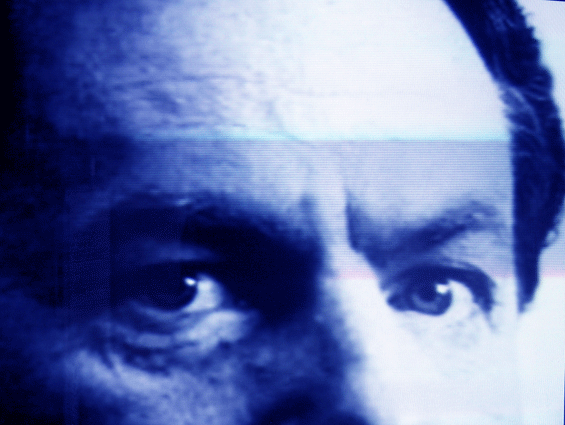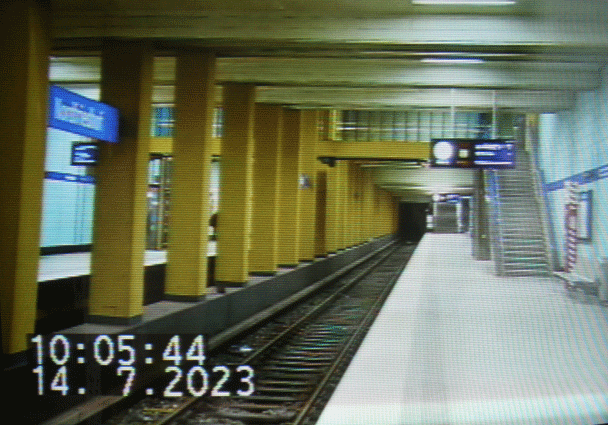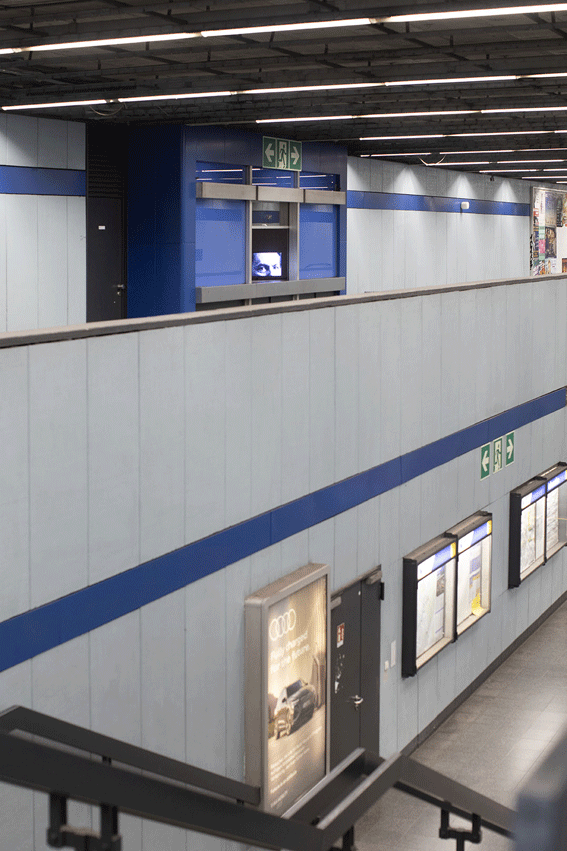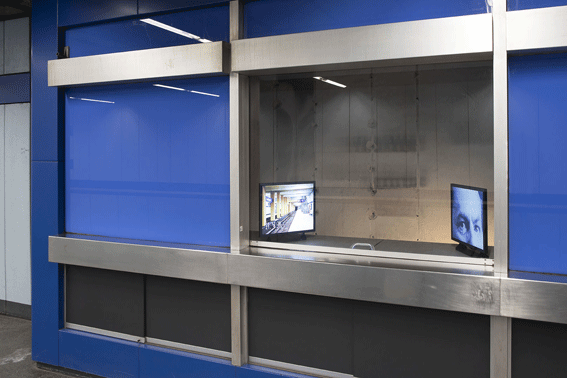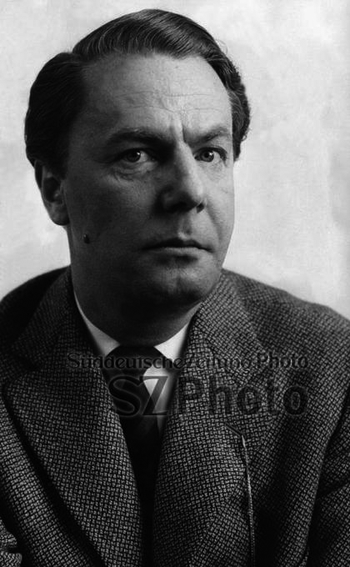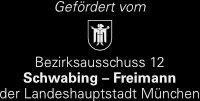ı
Alexander Steig
NESTLER-TV (STAR #10)
2-channel closed-circuit video production, former kiosk, barrier floor north, subway station Nordfriedhof, Munich
Open continuously from September 20 to October 31, 2023.
Monitor image 1
If you enter Munich's Nordfriedhof subway station from the northern entrance, you reach the former kiosk on both sides via a gallery on the barrier floor, the front of which is divided into three window areas. Behind the two outer windows, two control monitors of current design are positioned opposite each other in such a way that people passing by can easily see the screens. On the left screen, a pair of eyes can be seen in full format, apparently moving slightly and looking at the opposite monitor, but also out of the window of the kiosk. The monitor on the right shows a camera or video image of the deserted outbound train track of the Nordfriedhof subway station with a current, i.e. continuous, time stamp (date, time running at the bottom right of the image), so that the impression is created here that this is a live transmission from a surveillance camera from the track area of the station below. On the rear, black-painted inner wall of the kiosk near the floor, the viewer:inside recognizes two photos hanging side by side (approx. A4 portrait and landscape format) on closer inspection. One shows a black-and-white portrait of a man unknown to the majority (Paolo Nestler, photo circa 1965[1]), the other shows the North Cemetery track area in color (photo from 2017). A video camera is positioned in front of each photo, possibly recording the respective photo and transmitting it directly to one of the two monitors.
Monitor image 2
The entire setting appears unpretentious, rough, poor, and semi-provisional, yet theatrical. The apparent live transmission of the track area, to which this barrier floor leads, seems familiar; only the fact that the track area remains permanently empty (despite the current time stamp) could be irritating. The pair of eyes of the architect Paolo Nestler, who is responsible for the sober station design of most of the stations of the first subway line U6, which was opened for the 1972 Summer Olympics, looks at or rather monitors with permanently open eyes incessantly within the structure designed by him the video transmission of "his structure" (track area opposite or below the gallery).
Design collage
On January 31, 1965, the groundbreaking ceremony for the construction of Munich's subway network was held at the Nordfriedhof subway station. The symbolic start of construction followed two days later with the anchoring of the first steel girder by Bavarian Minister President Alfons Goppel and Munich Mayor Hans-Jochen Vogel at the same location. In addition, the first topping-out ceremony for a Munich subway station was celebrated here on October 7, 1966. Regular subway service began on October 19, 1971, along with the opening of the line between the 13 stations at Goetheplatz and Kieferngarten. A good 50 years later, the architect of the Nordfriedhof station, Paolo Nestler, posthumously and intermedially enters into a current dialogue with his work directly where it was first designed.
A good 50 years later, the architect of the North Cemetery Station, Paolo Nestler, enters posthumously and intermedially across time into a current dialogue with his work directly there, where the same experienced the first design. In addition to this "silent meditation" on Nestler's work, the intimate, almost contemplative dialogue from subject to or about object - which is simultaneously conducted in public -, in addition to the focus on a deceased person and his work[2], which "unrecognized" encountered millions of citizens of the state capital, the artistic intervention NESTLER-TV / STAR #10[3] also questions the role of architecture as a codification of socio-political constitution, examines control mechanisms and strategies of various actors: (here MVV) in the public space between promise of security and loss of intimacy, brings in three acts (windows) a 24/7 CCTV chamber play on stage, lets a "virtual pair of eyes" monitor the simulated surveillance of a "danger area" and thereby involves the viewer:s outside in front of the "theater kiosk" to reflect on this place, its history and function, as well as on their own perception of the public space. NESTLER-TV / STAR #10 works against the supposed a priori knowledge about this place and invites to identify seemingly familiar surroundings in general as inconstant and to look at them in a more differentiated way.
Photos: Toby Binder
[1] In 1965, the architect Paolo Nestler (1920-2010), who taught interior design as a professor at the Academy of Fine Arts in Munich from 1959 to 1985, won the architectural competition for the station design of the U6 (Nordfriedhof, Dietlindenstraße, Münchner Freiheit, Gieselastrasse Universität, Odeonsplatz, Sendlinger Tor, Goetheplatz, and later Implerstrasse, Harras, Mangfallplatz, and Klinikum Großhadern) with the concept of furnishing the stations in a functional and simple manner and keeping them easily distinguishable through color and shape coding of the columns.
[2] Paolo Nestler was responsible for more than 25 other building projects in Munich and elsewhere, including the temporary extension of the Haus der Kunst during the 1972 Summer Olympics and the Sound Center for Experimental Music, as well as the foyer of the UN, New York, together with Günter Fruhtrunk in 1979. He published and taught architectural theory, served as president of the AdBK Munich (1965-69), and was a member of the Berlin Academy of Arts, Building Art Section, from 1968.
[3] In the serial series STAR, I have been medially and stagingly questioning 9 deceased persons at places of their life and/or work since 2003, e.g. in 2018 (STAR #9) the artist and reformer Johann Heinrich Vogeler at the Barkenhoff Worpswede, his former place of work. Work place, 2016 (STAR #8) Franz Josef Strauß in the Ermekeilkaserne Bonn (his workplace as 2nd Minister of Defense) or 2007 (STAR #4) Karol Wojtyła (i.e. Pope John Paul II) at the College of Humanities and Journalism in Poznan (PL).

Design sketch and portrait photo by Paolo Nestler.
Figure credits: Prof. Paolo Nestler (architect): Copyright photo archive Otfried Schmidt/Süddeutsche Zeitung Photo.
Subway station template: Florian Schütz, Munich
© Alexander Steig, VG Bild-Kunst, Bonn 2023.
The video staging NESTLER-TV (STAR #10) is part of "Kunst Kioske," a citywide project to revitalize the vacant kiosks in Munich's subway stations through artistic interventions selected in a two-stage competition. Project management/concept and curation: Corbinian Böhm and Gabi Blum, BBK München und Oberbayern e.V. and Dr. Christian Landspersky, PLATFORM Munich. Further information at: kunstkioske.de
Supported by BA 12, Schwabing-Freimann of the City of Munich
Supported by the NEUSTARTplus grant, Stiftung Kunstfonds, Bonn
